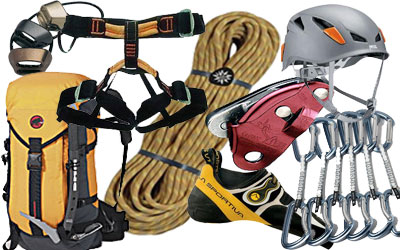
Equipment
One of the major appeals of bouldering is its relatively scant equipment requirements. It is not uncommon to see people bouldering with shoes, a chalkbag, and a small mat to wipe their feet on. Although nothing is actually required, common equipment includes:
- Loose, powdered chalk as a hand drying agent while climbing.
- A mattress-like object called a crash pad. These are generally thick, rectangular foam pads with a heavy-duty fabric shell. They are opened and placed at the base of a boulder to cover irregularities in the landing and provide some cushion if the climber falls.
- Climbing shoes, for better traction and edging capabilities.
- A brush, or several brushes of differing sizes, typically with nylon bristles but sometimes coarse animal hair, is used to clean holds and is often mounted on a telescopic pole to allow greater reach.
- Sports tape is useful for covering cuts or blisters, as well as providing support for joints that may have been strained.
- Clothing usually include a sleeveless shirt and shorts, though anything that's comfortable and flexible enough will generally work.
Climbing equipment
A wide range of equipment is used during rock climbing. The most popular types of climbing equipment are briefly described in this article. The article on protecting a climb describes equipment commonly used to protect a climber against the consequences of a fall.
Rope, cord and webbing
 Climbing ropes are typically of kernmantle construction, consisting of a core (kern) of long twisted fibres and an outer sheath (mantle) of woven coloured fibres. The core provides about 80% of the tensile strength, while the sheath is a durable layer that protects the core and gives the rope desirable handling characteristics.
Climbing ropes are typically of kernmantle construction, consisting of a core (kern) of long twisted fibres and an outer sheath (mantle) of woven coloured fibres. The core provides about 80% of the tensile strength, while the sheath is a durable layer that protects the core and gives the rope desirable handling characteristics.
Ropes used for climbing can be divided into two classes: dynamic ropes and static ropes. Dynamic ropes are designed to absorb the energy of a falling climber, and are usually used as Belaying ropes. When a climber falls, the rope stretches, reducing the maximum force experienced by the climber, his belayer, and his equipment. Static ropes stretch much less, and are usually used in anchoring systems. They are also used for abseiling (rappeling) and as fixed ropes climbed with ascenders.
Modern webbing is often made from dyneema, which is usually stronger and lighter than nylon. While 12 mm dyneema slings have a tensile strength of around 22kN, a one-inch (25-mm) tubular climb-spec nylon webbing has a tensile strength of about 20 kN (4000 pounds). Some webbing is tubular or hollow core and is advantageous because rope can be placed inside of it, preventing damage to the sheath of a kernmantle rope if it hangs over a sharp edge. Webbing is inexpensive when compared with climbing rope.
When webbing is sewn together at the ends (using reinforced stitching), it becomes known as a sling or runner, and if you clip a carabiner to each end of the sling, you have a quickdraw. Webbing has many uses such as extending the distance between protection and a tie-in point, an anchor extension or equalization, securely anchoring a belayer (typically when the climber is heavier than the belayer), creating makeshift harnesses, carrying equipment, and as a component of quickdraws. Webbing is usually tied (using a water knot or beer knot).
Carabiners
 Carabiners are metal loops with spring-loaded gates (openings), used as connectors. Once made primarily from steel, almost all carabiners for recreational climbing are made from a light weight aluminum alloy. Steel carabiners are harder wearing, but much heavier and often used by instructors when working with groups. Carabiners exist in various forms; the shape of the carabiner and the type of gate varies according to the use for which it is intended. There are two major varieties: locking and non-locking carabiners. Locking carabiners offer a method of preventing the gate from opening when in use. Locking carabiners are used for important connections, such as at the anchor point or a belay device. There are several different types of locking carabiners, including a twist-lock and a thread-lock. Non-locking carabiners are commonly found as a component of quickdraws.
Carabiners are metal loops with spring-loaded gates (openings), used as connectors. Once made primarily from steel, almost all carabiners for recreational climbing are made from a light weight aluminum alloy. Steel carabiners are harder wearing, but much heavier and often used by instructors when working with groups. Carabiners exist in various forms; the shape of the carabiner and the type of gate varies according to the use for which it is intended. There are two major varieties: locking and non-locking carabiners. Locking carabiners offer a method of preventing the gate from opening when in use. Locking carabiners are used for important connections, such as at the anchor point or a belay device. There are several different types of locking carabiners, including a twist-lock and a thread-lock. Non-locking carabiners are commonly found as a component of quickdraws.
Carabiners are made with many different types of gates including wire-gate, bent-gate, and straight-gate. The different gates have different strengths and uses. Most locking carabiners utilize a straight-gate. Bent-gate and wire-gate carabiners are usually found on the rope-end of quickdraws, as they facilitate easier rope clipping than straight-gate carabiners.
Carabiners are also known by many slang names including biner (pronounced beaner).
Quickdraws
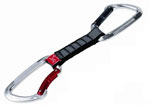 Quickdraws (referred to as "draws" by many climbers) are used by climbers to attach ropes to bolt anchors or protection. They allow the rope to run through with minimal friction. A quickdraw consists of two non-locking carabiners connected by a short, pre-sewn loop of webbing. Alternatively, and quite regularly, the pre-sewn webbing is replaced by a sling of the pre-mentioned dyneema/nylon webbing. This is usually of a 60cm loop and can then be tripled over between the carabiners to form a 20 cm loop. Then when more length is needed it can be made back into a 60cm loop offering more versatility than a pre-sewn loop. The carabiner meant for clipping into the protection generally has a straight gate, to decrease the possibility of the carabiner accidentally unclipping from the protection. The carabiner into which the rope is clipped often has a bent gate, so that clipping the rope into this carabiner can be done quickly and easily.
Quickdraws (referred to as "draws" by many climbers) are used by climbers to attach ropes to bolt anchors or protection. They allow the rope to run through with minimal friction. A quickdraw consists of two non-locking carabiners connected by a short, pre-sewn loop of webbing. Alternatively, and quite regularly, the pre-sewn webbing is replaced by a sling of the pre-mentioned dyneema/nylon webbing. This is usually of a 60cm loop and can then be tripled over between the carabiners to form a 20 cm loop. Then when more length is needed it can be made back into a 60cm loop offering more versatility than a pre-sewn loop. The carabiner meant for clipping into the protection generally has a straight gate, to decrease the possibility of the carabiner accidentally unclipping from the protection. The carabiner into which the rope is clipped often has a bent gate, so that clipping the rope into this carabiner can be done quickly and easily.
Harnesses
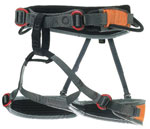 A harness is used for attaching the rope to a person. Most harnesses used in climbing are worn around the pelvis, although other types are used occasionally.
A harness is used for attaching the rope to a person. Most harnesses used in climbing are worn around the pelvis, although other types are used occasionally.
Different types of climbing warrant particular features for harnesses. Sport climbers typically use minimalistic harnesses, some with sewn-on gear loops. Alpine climbers often choose lightweight harnesses, perhaps with detachable leg loops. Big wall climbers generally prefer padded waist belts and leg loops. There are also full body harnesses for children, whose pelvises may be too narrow to support a harness appropriately. These harnesses prevent children from falling even when inverted, and are either manufactured for children or constructed out of webbing. Some climbers use full body harnesses when there is a chance of inverting, or when carrying a heavy bag. There are also chest harnesses, which are used only in combination with a sit harness; this combination provides the same advantages as a full body harness. However, test results from UIAA show that chest harnesses can put more impact on the neck than sit harnesses, making them slightly more dangerous to use.
Apart from these harnesses, there are also caving and canyoning harnesses, which all serve different purposes. For example, a caving harness is made of tough waterproof and unpadded material, with dual attachment points. Releasing the maillon from these attachment points loosens the harness quickly.
Canyoning harnesses are somewhat like climbing harnesses, often without the padding, but with a seat protector, making it more comfortable to rappel. These usually have a single attachment point of Dyneema.
Belay devices
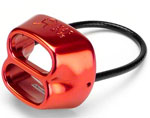 ATC-XP on locking carabiner
ATC-XP on locking carabiner
These are mechanical friction brake devices used when belaying. They allow careful control of the belay rope. Their main purpose is to allow locking off of the rope with minimal effort. Many types of belay devices exist, and some of these may additionally be used as descenders, for controlled descent on a rope, that is, abseiling or rappeling.
There are passive camming devices and active camming devices. Passive camming devices rely on the brake hand and a carabiner to lock off the rope. Sticht plates and the Air Traffic Controller ATC are examples of passive camming devices.
Active camming devices have a built-in mechanism that locks off the rope without the help of any other pieces of equipment. A GriGri is an example. The offset cam in the GriGri locks off the rope automatically to catch a falling climber, much like a seatbelt in a car locks off to hold a passenger securely. The GriGri fails at around 9 kN of force.
However, a GriGri, with its technology, often makes belayers become less vigilant. The GriGri is not a hands-free belay device. One mistake with the GriGri is reverse threading it. Reverse threading means to thread the GriGri the wrong way around, rendering the camming action useless. However, in a fall, with a reverse threaded GriGri, bending the rope sharply under the GriGri provides more than enough friction to hold a falling climber.
An example of traditional belay is the Body Belay or the Hip Belay, where the rope is wrapped around the body to provide enough friction to catch a climber. This is often used in Alpine climbing, where the routes are easy, and the belay must be fast.
Ice climbers often use a boot belay, where the rope is wrapped around one boot, thus providing friction.
Rappel devices (descenders)
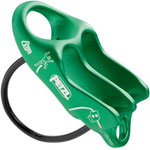 These devices are friction brakes which are designed for descending ropes. Many belay devices can be used as descenders, but there are descenders that are not practical for belaying, since it is too difficult to feed rope through them, or because they do not provide sufficient friction to hold a hard fall.
These devices are friction brakes which are designed for descending ropes. Many belay devices can be used as descenders, but there are descenders that are not practical for belaying, since it is too difficult to feed rope through them, or because they do not provide sufficient friction to hold a hard fall.
Figure eight
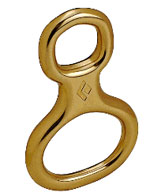 Sometimes just called "eight", this device is most commonly used as a descender, but may also be used as a belay device in the absence of more appropriate equipment, although it does not provide enough holding power for this to be recommended.
Sometimes just called "eight", this device is most commonly used as a descender, but may also be used as a belay device in the absence of more appropriate equipment, although it does not provide enough holding power for this to be recommended.
It is an aluminium (or occasionally steel) "8" shaped device, but comes in several varieties. Its main advantage is efficient heat dissipation. A square eight, used in rescue applications, is better for rappelling than the traditional 8. On the rescue 8 the "ears" or "wings" are larger which means there is less chance of forming a larks head or girth hitch whilst rappelling very quickly.
A figure eight descender
Figure eights allow fast but controlled descent on a rope. They are easy to set up and are effective in dissipating the heat caused by friction but have a tendency to put a twist in the rope. Holding the brake hand off to the side twists the rope, whereas holding the brake hand straight down, parallel to the body, allows a controlled descent without twisting the rope. An 8 descender can wear a rope quicker than a tube style belay/rappel device because of the many bends it puts into the rope. Many sport climbers also avoid them because of the extra bulk an 8 puts on the rack. However, many ice climbers prefer to use the 8, because it is much easier to thread with stiff or frozen rope.
Rescue eight
 A rescue eight is a variation of a figure eight, with "ears" or "wings" which prevent the rope from "locking up" or creating a larks head or girth hitch, thus stranding the rappeller on the rope. Rescue eights are frequently made of steel, rather than aluminium.
A rescue eight is a variation of a figure eight, with "ears" or "wings" which prevent the rope from "locking up" or creating a larks head or girth hitch, thus stranding the rappeller on the rope. Rescue eights are frequently made of steel, rather than aluminium.
Rappel Rack
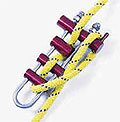 This consists of a 'U' shaped frame, attached to the rappeller's harness, into which snap multiple bars that pivot from the other side of the frame. The rope is woven through as many of the bars as are required to provide sufficient friction. This arrangement allows for variations in rope diameter and condition, as well as controlled rate of descent. Racks are seldom used in sport climbing. Cavers often use racks on long rappels because friction can be adjusted by adding or removing bars.
This consists of a 'U' shaped frame, attached to the rappeller's harness, into which snap multiple bars that pivot from the other side of the frame. The rope is woven through as many of the bars as are required to provide sufficient friction. This arrangement allows for variations in rope diameter and condition, as well as controlled rate of descent. Racks are seldom used in sport climbing. Cavers often use racks on long rappels because friction can be adjusted by adding or removing bars.
Ascenders
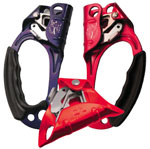 Ascenders are mechanical devices for ascending on a rope. They are also called Jumars, after a popular brand.
Ascenders are mechanical devices for ascending on a rope. They are also called Jumars, after a popular brand.
Jumars perform the same functionality as friction knots but are stronger, faster, safer and less effort is needed to use them. A Jumar employs a cam which allows the device to slide freely in one direction but tightly grip the rope when pulled on in the opposite direction. To prevent a jumar from accidentally coming off the rope, a locking carabiner is used. The Jumar is first attached to the climber's harness by a piece of webbing or sling, and then the Jumar is clipped onto the rope and locked. Two ascenders are normally used to climb a fixed rope. For climbing a fixed rope attached to snow anchors on a steep slope, only one Jumar is used as the other hand is used for holding the ice axe.
Another type of ascender allows rope to feed in either direction, slowly, but locks up when pulled quickly. Such self-locking devices allow people to protect solo climbs because the amount of rope is automatically adjusted.
Slings
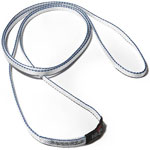 A sling or runner is an item of climbing equipment consisting of a tied or sewn loop of webbing that can be wrapped around sections of rock, hitched (tied) to other pieces of equipment or even tied directly to a tensioned line using a prusik knot, for anchor extension (to reduce rope drag and for other purposes), equalisation, or climbing the rope.
A sling or runner is an item of climbing equipment consisting of a tied or sewn loop of webbing that can be wrapped around sections of rock, hitched (tied) to other pieces of equipment or even tied directly to a tensioned line using a prusik knot, for anchor extension (to reduce rope drag and for other purposes), equalisation, or climbing the rope.
Daisy chain
 A daisy chain is a strap, several feet long and typically constructed from one-inch tubular nylon webbing of the same type used in lengthening straps between anchor-points and the main rope. The webbing is bar-tacked (sewn) across at roughly two inch intervals (or, in the past, tied) to create a length of small loops for attachment. Unlike the use of similar devices in backpacking, daisy chains in technical rock climbing are expected to be of sufficient strength to be "load bearing," i.e., capable of withstanding forces sustained by the anchor system in a fall.
A daisy chain is a strap, several feet long and typically constructed from one-inch tubular nylon webbing of the same type used in lengthening straps between anchor-points and the main rope. The webbing is bar-tacked (sewn) across at roughly two inch intervals (or, in the past, tied) to create a length of small loops for attachment. Unlike the use of similar devices in backpacking, daisy chains in technical rock climbing are expected to be of sufficient strength to be "load bearing," i.e., capable of withstanding forces sustained by the anchor system in a fall.
Though daisy chains are sometimes used by free climbers as a type of chicken sling (a quick attachment used from harness directly to a belay anchor), and for ad hoc purposes similar to those of the backpacker, the canonic use for a daisy chain is in aid climbing, wherein the leader will typically attach one end to the harness, and the other to the top-most anchor placement (by carabiner or fifi hook), particularly after having ascended in etriers as high as possible. This allows the leader to hang from the daisy chain while preparing the next anchor placement. The closely spaced loops allow fine-tuning the length from harness to anchor, thereby allowing the best possible reach for the next placement.
Daisy chains should not be confused with etriers (aka aiders) which are short ladders made in the same way, but with larger loops, also used in aid climbing, nor with load-limiting devices often known as screamers (from their first trade name) designed to simulate a dynamic belay.
Protection devices
Protection devices, collectively known as rock protection or pro, provide the means to place temporary anchor points on the rock. These devices may be categorized as passive (nuts, Hexentrics, etc.) or active spring-loaded camming devices (SLCDs).
Nuts
 Typical nuts and a nut tool
Typical nuts and a nut tool
Black Diamond Hexcentrics
Nuts are manufactured in many different varieties. In their simplest form, they are just a small block of metal attached to a loop of cord or wire. The most popular styles are tapers and hexcentrics. They are sometimes referred to by the slang term, wires.
Nuts are used by simply wedging them into narrowing cracks in the rock, then giving them a tug to set them.
Hexcentrics
 Hexcentrics, usually called hexes, are a type of nut, a hollow eccentric hexagonal prism with tapered ends, usually threaded with tape. They are manufactured by several firms, with a range of sizes varying from about 10mm thick to 100mm wide. Sides may be straight or curved.
Hexcentrics, usually called hexes, are a type of nut, a hollow eccentric hexagonal prism with tapered ends, usually threaded with tape. They are manufactured by several firms, with a range of sizes varying from about 10mm thick to 100mm wide. Sides may be straight or curved.
Spring loaded camming devices
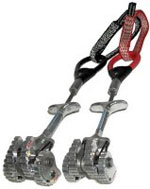 An SLCD placed in a crack.
An SLCD placed in a crack.
These consist of three or four cams mounted on a common axle or two adjacent axles, in such a way that pulling on the shaft connected to the axle forces the cams to spread further apart. The SLCD is used like a syringe, by pulling the cams via a "trigger" (a small handle) which forces them closer, inserting it into a crack or pocket in the rock, and then releasing the trigger. The springs make the cams expand and grip the rock face securely. A climbing rope may then be attached to the end of the stem via a sling and carabiner. SLCDs are typically designed to maintain a constant camming angle with the rock to ensure that the normal force provided by the cam lobes against the rock face will supply enough friction to hold a cam in equilibrium with the rock.
Tricams
 A Tricam is a passive or active device consisting of a shaped aluminium block attached to a length of tape (webbing). The block is shaped so that pulling on the tape makes it cam against the crack, gripping the rock tighter. Careful placement is necessary so that the "cam" does not loosen when not loaded. It is generally not as easy to place or remove as a SLCD but is much cheaper and lighter, and often is the only thing that will work in situations like quarry drill-holes and limestone pockets. The smaller sizes can work well in old piton scars, and can also be used passively as nuts.
A Tricam is a passive or active device consisting of a shaped aluminium block attached to a length of tape (webbing). The block is shaped so that pulling on the tape makes it cam against the crack, gripping the rock tighter. Careful placement is necessary so that the "cam" does not loosen when not loaded. It is generally not as easy to place or remove as a SLCD but is much cheaper and lighter, and often is the only thing that will work in situations like quarry drill-holes and limestone pockets. The smaller sizes can work well in old piton scars, and can also be used passively as nuts.
Specialised clothing
In the early days of climbing, many would have considered specialised clothing to be cheating. In fact, the first climbers considered an untucked shirt or unbuttoned sport jacket a sign of weakness. Several climbers even chose to climb bare foot, an act that modern climbers would find amazing. In the 80s and early 90s, the trend was to wear tight, brightly-colored clothes. The trend, now, is to wear looser fitting clothing.
Climbing shoes
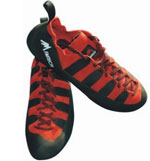 Specifically designed foot wear is usually worn for climbing. To increase the grip of the foot on a climbing wall or rock face due to friction, the shoe is covered with a vulcanized rubber layer. Usually, shoes are only a few millimetres thick and fit very snuggly around the foot. Stiffer shoes are used for "edging", more compliant ones for "smearing". Some have foam padding on the heel to make descents and rappels more comfortable.
Specifically designed foot wear is usually worn for climbing. To increase the grip of the foot on a climbing wall or rock face due to friction, the shoe is covered with a vulcanized rubber layer. Usually, shoes are only a few millimetres thick and fit very snuggly around the foot. Stiffer shoes are used for "edging", more compliant ones for "smearing". Some have foam padding on the heel to make descents and rappels more comfortable.
Belay gloves
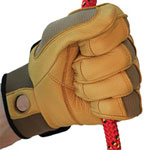 Belay gloves have been shunned by climbers who claim that gloves reduce grip on and control over the rope. For other climbers, belay gloves are a useful aid for belaying on long climbs. In particular, when lowering a climber they remove the possibility of rope burn and the subsequent involuntary release of the rope.
Belay gloves have been shunned by climbers who claim that gloves reduce grip on and control over the rope. For other climbers, belay gloves are a useful aid for belaying on long climbs. In particular, when lowering a climber they remove the possibility of rope burn and the subsequent involuntary release of the rope.
Belay gloves are constructed from either leather or a synthetic substitute. They typically have heat resistant padding on the palm and fingers.
It is very important to use gloves if using a classic or body belay.





